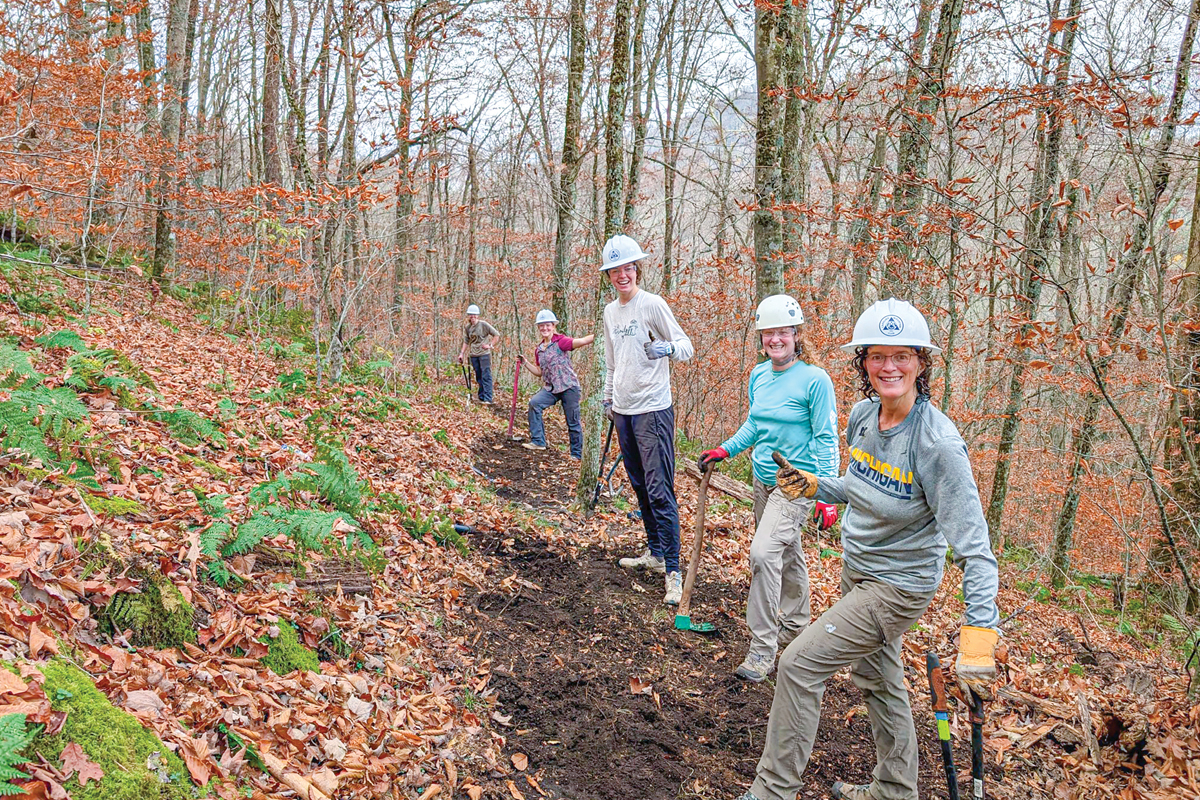Old Waynesville hospital could be converted to affordable housing
Haywood County officials foresee the historic hospital in Waynesville one day being transformed into affordable or senior housing.
“That would be my vision,” said Commissioner Bill Upton. “Something might show up that we haven’t thought of, but affordable housing is definitely needed.”
The mammoth brick building occupies an entire block, with 125 rooms and 50,000 square feet of outside space. The Department of Social Services is moving out next fall, and the county is seeking proposals on what to do with the building once vacated.
Developers have until late October to propose a new use for the hospital, but housing of some sort appears to be the commissioners’ preference.
“I felt that would be the highest and best use for that structure,” Commissioner Kevin Ensley said. According to Ensley, at least one developer has already looked at converting the building into affordable housing.
“I wouldn’t have any objection,” said Commissioner Skeeter Curtis. “We always need some housing.”
The Department of Social Services will relocate in fall 2011 to the site of the former Wal-Mart store in Clyde. Commissioners decided it’d be more cost-effective to buy and renovate the deserted superstore rather than fix up the crumbling hospital.
The old hospital was originally built in 1927 and expanded in the 1950s. County officials have said it would cost roughly $6.1 million to renovate it.
Commissioners have complained that the building will need a host of major renovations including a new roof, new windows and rewiring to accommodate the latest technology.
As the first county-owned hospital in North Carolina, however, the building may be eligible to be included in the National Registry of Historic Places, which comes with tax credits for renovations.
“I think the historic tax credits are what really makes it attractive for developers,” said Ensley.
A time of great need
Mountain Projects, a community action agency in Haywood and Jackson counties, may be on the ground assisting any developer that steps in.
“If they choose to do affordable housing, at that point, we’ll get involved,” said Patsy Dowling, director of Mountain Projects.
The agency can guide developers through the highly competitive process of receiving low-income housing tax credits from the North Carolina Housing Finance Agency.
Earlier this year, Mountain Projects helped launch Smokey Meadows, an affordable apartment complex in Canton. It filled up in record time.
Dowling is well-aware of the struggles that the working class faces in tracking down affordable housing, especially in recent times. She has seen the waiting list for affordable housing assistance backlogged for as long as three years.
“Our waiting list got so long we had to close it and stop taking applications,” said Dowling. “It’s back open, but the wait is tremendous …hundreds and hundreds of people in Haywood County are on the waiting list.”
Mountain Projects is helpless to help even those who walk in with their suitcases with nowhere to go.
While neighbors may be wary about living near low-income housing, Dowling said a comprehensive background check is done and clients must sign a strict 17-page lease.
“In these apartments, it’s not just anybody,” said Dowling.
Ensley agreed that bringing affordable housing to the area would only bring benefits.
“I don’t think that low-income or moderate-income housing is a negative at all,” said Ensley.
Another bonus is that the building would be put back on the tax rolls, Ensley and Dowling said. Affordable housing complexes not only pay taxes, but also create jobs.
If a developer takes on the task of renovating the old hospital, the central office for Haywood County Schools, which occupies one small section of the building, would likely be uprooted.
As commissioners await proposals, Curtis said the last thing he wants to see is the hospital destroyed.
“It’d be nice if we could save what we could of it,” Curtis said.
“A lot of our people were born there,” said Upton, who worked in the 1927 building while serving as school superintendent.
Waynesville debates which special events merit street closings
Waynesville’s town board is drawing the line at 14 Main Street closings annually.
As a result, the town has rejected a request to shut down part of Main Street to traffic for a Sept. 11 memorial ceremony.
The group organizing the memorial was hoping to close the area in front of the Haywood County Courthouse for three hours so that an American flag could be raised between two parked fire trucks during the ceremony. The group putting on the ceremony is the 9-12 Project, a political group that shares many of the philsophies and goals of the Tea Party.
Representing the 9-12 Project, Jan Sterret said she wanted to interrupt traffic as little as possible.
“I think the greatest thing is the visual of the two fire trucks with the huge flag hanging down,” said Sterret. “It would be very meaningful for a lot of people.”
But Mayor Gavin Brown, Town Manager Lee Galloway and town aldermen expressed concerns about irking the N.C. Department of Transportation with yet another closing. Main Street doubles as U.S. 276, a state maintained highway, and is not technically under the town’s jurisdiction.
Whether it’s for a street dance, International Festival Day or a block party, closing Main Street requires permission from DOT 60 days in advance.
So far, the DOT hasn’t objected to the large number of street closings in Waynesville.
“Although they don’t particularly care for it, they’ve allowed it,” said Alderman LeRoy Roberson.
But town officials fear the DOT might begin clamping down if the town adds any more closings to the list.
“Sooner or later, DOT’s going to start knocking on the door,” said Brown.
Jonathan Woodard, a DOT district engineer over Haywood, Jackson and Swain counties, said he would normally expect one or two street closings a year.
“I wouldn’t expect it to be an every weekend or once-a-month type situation,” said Woodard.
Though 14 street closings a year certainly doesn’t meet that threshold, Woodard said it really depends on which street is being closed.
Making the call
Festivals and events that have historically been part of Waynesville’s repertoire will likely continue to be approved for street closings.
“The newer ones have a tougher time, there’s no question,” said Brown.
Even the Haywood County Chamber of Commerce’s request to shut down Main Street for the inaugural Fire & Ice festival last winter was denied. The detour would take drivers down the much steeper Depot Street.
“If it was snowy or icy, that could be a hazard that we were directing people into,” said Galloway.
Waynesville’s tight budget continues to remain a concern. During each street closing, town employees must set up and remove barricades and clean up streets during the aftermath. A few extra police officers are often called in to work the events.
“We have to try to control those costs to some degree,” said Galloway.
Brown’s other reservation was that the 9-12 Project is not a legal entity that could held responsible if something went awry during the Sept. 11 memorial.
“You would rather have a group of individuals who collectively take responsibility,” said Brown. “And the 9-12 group is not organized like that.”
In contrast, the Downtown Waynesville Association — which coordinates most of the events on Main Street — is an established organization that carries a large insurance policy for its festivals.
Brown said the 9-12 Project didn’t notify the town until Aug. 17 of its request for a street closing, while the Downtown Waynesville Association applies annually for street closings every February.
“It shows me a lack of coordination,” said Brown.
With about 100 people showing up at the Sept. 11 memorial last year, town officials say the Haywood County courthouse lawn will easily accommodate the entire ceremony again. Fire Chief Joey Webb is working with the group to possibly close down Depot Street to allow a flag to be draped across two fire trucks.
Buffy Messer, director of the DWA, points out that unlike other towns, side streets can’t always accommodate events. The Apple Festival once took place on Church Street, but its slope made setting up booths challenging.
“Main Street is just on this little ridge,” said Messer. “All the side streets are sloped. Our topography is just a little different than any other town.”
HART presents the Southern comedy ‘Catfish Moon’
The Haywood Arts Regional Theater’s next play never played Broadway, or even New York, but it is one of the most popular comedies being done today.
“Catfish Moon” by Laddy Sartin tells the story of a group of close friends who have had a break up and are working towards a reconciliation — or trying to. The entire thing is set on a fishing pier complete with cooler, beer, rods, lawn chairs and a full moon and plenty of laughs — an appropriate way to spend a summer evening.
HART’s production is being directed by Allison Stinson and will feature Jessica Bachar, Tom Dewees, Jackie Webb and Jack Ross. This is a feel-good comedy that will leave you with some things to ponder, and a greater appreciation for a full moon on a summer night.
Laddy Sartin is currently a resident of Rock Hill, S.C., and a Mississippi native. She holds a BFA in Theatre from the University of Southern Mississippi. An actor and stage technician as well as a writer, Sartin has worked in theatre for the past two decades.
In the 1970’s and 80’s he appeared as an actor on a number of TV series including “Matlock,” but then he became a father and things changed. His wife had been the family’s principal moneymaker as a theatre technician working on “A Chorus Line,” but the family decided to leave the city and take a different direction. Sartin had been writing for years and he dug back into his trunk and found parts of what would become two celebrated plays, “Blessed Assurance” and “Catfish Moon.”
Sartin was the 1991-92 recipient of the North Carolina Arts Council’s Playwriting Fellowship, the state’s most prestigious individual artist award and then “Blessed Assurance” was selected for the Eudora Welty New Play Series at New Stage Theatre in Jackson, Mississippi, and was performed there in March 1995.
In the fall of 1992 “Blessed Assurance” was produced by Catawba College in Salisbury, N.C., and was their entry in the American College Theatre Festival and received national attention. The play was also produced by the University of Southern Mississippi in September 1993 and by West Georgia College in February 1994.
Waynesville’s special police unit puts new spin on fighting crime
Not long ago, Waynesville’s historic Frog Level district was fraught with littered beer bottles and an unrelenting band of vagrants.
“Sleeping under back decks, defecating on front doorsteps, leaving wine bottles and beer cans,” said Lieutenant Brian Beck. “The creek banks looked worse than the landfill.”
The historically bustling railroad and industrial district is just a few blocks from Main Street and was recently revitalized. But it continued to be a gathering spot for the homeless, partly due to the proximity of the Open Door soup kitchen.
Now, Beck says complaints from Frog Level have gone down drastically.
“The business owners are very happy. People can walk down the street without being accosted,” said Beck.
Crucial in the cleanup was the Special Projects Unit at the Waynesville Police Department — a division of law enforcement that is rare in most small towns, especially those west of Asheville.
Police Chief Bill Hollingsed, who has supervised similar units at other agencies, resolved to start something comparable in Waynesville about two years ago.
The Special Projects Unit currently includes five officers fully devoted to community outreach and crime prevention in neighborhoods that are regularly problematic.
“When [neighbors] have to pick up the phone and call several times a day or week over the same house or the same problem over and over again, they get frustrated, we get frustrated,” said Hollingsed. “Instead of reactively responding to calls, we’re trying to be proactive.”
Because Frog Level had its fair share of repeat offenders, SPU officers stepped up their presence in the district and even ordered litterers clean up their own trash.
“They’ve been better than better,” Brian Pierce, owner of Panacea Coffee House in Frog Level, said of the special unit officers. “Patrol officers come down usually every morning and sit in the parking lot and watch things, make their presence known.”
It’s just one example of the many projects SPU busies itself with regularly.
Officers conduct driver’s license checkpoints in areas with rampant speeding. One works full-time patrolling schools to curb drug problems and fights.
The unit also conducts D.A.R.E. programs in the school. It offers presentations to store owners on how to best secure their businesses. Officers even fingerprint children at special community events for parents to keep on file in case they are ever kidnapped.
Battling drugs
SPU officers routinely help rid neighborhoods of drug houses where illegal deals are frequently made and violence is likely to break out.
In extreme circumstances, SPU can use the civil nuisance law to force property owners to forfeit the house. Most commonly, however, drug-dealing tenants are kicked out by their landlords, according to Sergeant Sylvia McMahan with the Special Project Unit.
The SPU has helped seize cocaine and, in one case, $8,000 in drug money.
But solving most cases requires patience, McMahan points out. Officers keep detailed notes on everything they observe and keep in mind that they’re taking a long-term approach.
“It’s not a quick fix,” said McMahan. “It’s a long, drawn-out process.”
In Waynesville, the secret to the Special Projects Unit’s success has a lot to do with flexibility. Since officers aren’t usually tied down with routine patrol shifts, they can go into a community and take the time to work on bigger picture issues, from code enforcement to animal control to extra special attention with surveillance.
“We can be there basically around the clock until we get the problem solved,” said McMahan. “We have more time to spend in a certain area than what your regular patrol officer does.”
Despite SPU’s success, most Waynesville residents aren’t yet in the know about the unit.
“I don’t think they know what we do,” said McMahan. “We’re sort of behind the scenes.”
Rare in WNC
To Chief Hollingsed, preventing crime on the front end reduces the crime load that would otherwise land on the plate of regular patrol officers — making it a good use of resources. But it’s a luxury other small town police departments say they couldn’t afford.
With fewer than 10 officers working at the Bryson City Police Department, Chief Rick Tabor said it’d be impossible to have a whole unit devoted to preventing crime.
“I would love to have the resources to have anything like that, even if it was just one person,” said Tabor.
Det. John Buchanan with Sylva Police said at this time, all officers are required to keep a log of noteworthy events during their shifts. The assistant chief of police reviews those logs and asks patrol to be stepped up in areas with high incidents of crime.
“Our resources are so small here,” said Buchanan. “We just kind of have to do what we can.”
“Fantasies in Fiber and Fabric” come to life
“Fantasies in Fiber and Fabric,” an exhibition of three-dimensional garments, hats, bags, and one-of-a-kind original dolls by Toni Carroll, will run from Wednesday, Aug. 25, to Saturday, Sept. 18, at Gallery 86 in Waynesville.
Gallery hours are 10 a.m. to 5 p.m. Monday through Saturday. There will be a special artist’s reception from 6 to 9 p.m. on Friday, Sept. 3, in conjunction with the Waynesville Gallery Association’s Art After Dark event.
Inspired by nature and driven by passion, Toni Carroll’s work in “Fantasies in Fiber and Fabric” are enchanting and astonishingly beautiful. A Jackson, Miss., native currently living in North Carolina and Florida, Carroll shares her zeal of fabrics and design.
Waynesville farmer’s markets learn to coexist after split
Twenty-five years ago, a fledgling farmers market got its modest start in a small parking lot on Waynesville’s Main Street with only two vendors.
Today, Waynesville is home to two farmers markets — held on the same day, at the same time and less than half a mile apart.
The rarity of two markets in a town the size of Waynesville shows a clear love for local produce. But the dual markets stems from key philosophical differences among the vendors, which ultimately led to a split. Two years since the divorce, leaders of both markets say a reconciliation is still nowhere in sight.
“They are pretty well set to continue on the way they are,” said Joanne Meyer, a member of Haywood’s Historic Farmer’s Market board. “We will continue on the way we are. We have always said they were welcome to join us. They would have done so by now if that’s what they wanted to do.”
“I don’t see a problem with it continuing being two markets,” said Judy West, co-market manager of the Waynesville Tailgate Market, the original market in town. “They’re new-age, and we’re old-age.”
With one vendor already at 90 years old and others in their 80s, Judy West estimates that her vendors have more than a 1,000 years of gardening and farming experience under their belts.
However, the Historic market, too, has many old-timers in its ranks, including mountain farming families going back several generations, who sell alongside young farmers and transplants to the area.
Steve West, former director of the Haywood County Extension Office, remembers the early efforts to start Haywood County’s first farmers market. He led a dogged phone campaign to entice farmers and home gardeners to the market, which expanded little by little until eventually its own success got the better of it.
By the summer of 2008, the Tailgate Market was bulging at the seams and could no longer fit in the confines of the Main Street parking lot.
As farmers hunted for a new location, a difference in philosophy that had been brewing below the surface finally boiled over, and vendors went their separate ways.
Each market seems content to continue operating under its own ideology.
“We deal strictly with fresh fruits and vegetables,” said West. “We think a farmers market and tailgate markets, any way you want to slice it, should be about fruits and vegetables.”
Unlike its counterpart, the Historic market allows vendors from counties that are adjacent to Haywood, as well as farmers selling eggs, cheese, homemade breads, jams, meat, seafood and heritage crafts.
Meyer pointed out that at the Historic market, seafood is delivered right from the North Carolina coast the day after it’s caught.
“Everything’s very fresh,” said Meyer. “It’s just wonderful to have that available in this area.”
A looming threat
West can only think of one scenario in which the two markets will merge. The Food Safety Modernization Act, which is being considered by federal legislators, has the potential to impose costly new requirements at farms. Depending on the version that is passed, the burden might be too heavy for small-scale farmers to shoulder. West fears only large, commercial farms will be able to survive the tougher regulations. Farmers left standing might have to band together at one market since their numbers will likely decline drastically.
“It’s going to hurt a lot of markets, not just ours,” said West.
West’s husband, Steve, anticipates the worst if a strict version of the federal law is passed.
“You will see these markets belly up across the country,” he said.
Meyer said for now, she and her counterparts are just waiting to see if the bill is passed.
“On the one hand, you want to see food safety,” said Meyer. “But it seems like maybe the government ought to concentrate more on the agri-business and leave the small farmers some room.”
Steve West pointed out that most farmers at markets aren’t exactly making a killing.
“We’re not rich growing squash, you know,” Steve West said. “Most of us do it because we enjoy growing and we enjoy meeting people.”
Have your pick
• Haywood’s Historic Farmer’s Market at the HART Theater in Waynesville. 8 a.m. to 1 p.m. Wednesdays and Saturdays May through Oct. 828.627.3469. www.waynesvillefarmersmarket.com.
• Waynesville Tailgate Market at the American Legion in Waynesville. 8 a.m. to 12 p.m. Wednesdays and Saturday June through Oct. 828.456.3517. In marking its 25th anniversary, the Waynesville Tailgate Market will have a $50 cash giveaway this week. Entries will be taken at the market on Wednesday, Aug. 11, and Saturday, Aug. 14.
Waynesville celebrates Art After Dark on Aug. 6
The monthly Art After Dark will take place from 6 to 9 p.m. on Aug. 6 in Waynesville. Sponsored by The Waynesville Gallery Association, Art After Dark takes place the first Friday of each month, May through December.
Enjoy a stroll through working studios and galleries on Main Street, Depot Street and in Historic Frog Level. Festive flags identify participating galleries, while Steve Whiddon will provide music on the street.
• The wire-wrapping art of Nadine Fidelman will be featured at The Jeweler’s Workbench from 6 to 9 p.m. Friday, Aug. 6, at Waynesville’s Art After Dark.
Fidelman searches out the best gemstones, pearls, fossils and dichroic glass from the world’s top suppliers to use in her one-of-a-kind pendants and earrings. She “wraps” each one, surrounding it with a minimal amount of wire, to enhance its beauty.
• Burr Studio will be featuring woodcarver Dennis Ruane for the month of August. Many folks will remember Dennis from the Hardwood Gallery previously located on Main Street in Waynesville.
• Earthworks Gallery is proud to feature the work of nationally-acclaimed artist Bonnie Marris and the fanciful creations of Ruth Apter as it celebrates August Art After Dark.
• Ridge Runner Naturals Studio & Gallery will be hosting a Trunk Showing of new creative, one-of-a-kind jewelry pieces by Waynesville artist Keri Anna Kelley. Kelly will be sharing her inspiration and design process. Wine and cheese will be served.
www.waynesvillegalleryassociation.com or 828.452.9284.
Honoring four-legged friends at Twigs and Leaves
Twigs and Leaves Gallery is celebrating our four-legged companions with a special Art After Dark tribute from 6 to 9 p.m. Friday, Aug. 6.
Having recently lost its gallery dog, Twigs and Leaves will honor Debbie, who welcomed thousands of customers, with a tree planting on Wall Street. The gallery will also be fundraising for The Francis Fund, which helps injured and sick creatures who are abandoned or homeless and will help the pets of people in financial difficulty.
Clay animal artist “Old Dog” will be in the gallery, and he and Twigs and Leaves Gallery will donate the profit of the sales of Old Dogs dogs to the fund. Munch on “dog treats,” stroll the gallery with its more than 170 artists, and enjoy familiar tunes on the piano.
www.twigsandleaves.com.
Opponents win concessions in first round of quarry permit fight
The state has delayed issuing a necessary permit and instead is asking Harrison Construction to provide a slew of additional information to ensure the expansion won’t create an environmental hazard or safety risk.
“They need to be more responsible. We felt that and we proved that,” said Suzanne Hendrix, one of dozens of neighbors who organized against the quarry. “It took a big effort on everyone’s part.”
From the impacts of blasting on drinking wells to the stability of its massive rock walls, the quarry must address a laundry list of concerns before the N.C. Division of Land Resources will entertain the expansion permit.
The quarry received a letter from the state in late June requesting additional information and has 180 days to reply. Judy Wehner, assistant state mining specialist, said she has no indication from the quarry when it might respond. The quarry did not return phone calls and emails seeking comment.
Neighbors of the quarry are optimistic, but also skeptical.
“Their track record isn’t good,” said Polly Leatherwood, 69, who has lived near the quarry her whole life. “If they do what they are supposed to, it would be fine.”
But state environmental inspectors visit too infrequently —with a lapses spanning more than two years by some agencies and four years by others — and aren’t diligent enough when they do, according to neighbors.
“They need to follow up on them and see they do what they say they are going to do. That’s the biggest thing,” said Leatherwood.
Ronnie Deweese agreed the state’s request for additional information won’t work unless regulatory oversight is ramped up going forward.
“They can provide all the information they want, but if they don’t have an inspection every so often it won’t do no good,” said Deweese, who lives near the quarry.
Shoring up quarry walls
The biggest issue the quarry must address is the stability of the quarry walls, which tower hundreds of feet in the air. Last year, a slab of rock hundreds of feet wide and tall came crashing down at the quarry. The potentially fatal slide could have been prevented had the quarry practiced more careful geotechnical monitoring, according to geologists and mine inspectors that visited the site in the aftermath.
But there are no state or federal engineering standards that apply to quarries, nor do state or federal agencies oversee the blasting and excavation plans. There are no rules limiting how steep or tall quarry walls can be.
In the new permit, however, the state took the quarry to task over its plans to stabilize and shore up the slide area.
Plans submitted by the quarry “contained insufficient information to assess the stability of rock soils and slopes,” according to the state’s letter. The quarry must provide more detailed engineering plans and slope assessments before the permit can proceed.
Quarries generally are not required to hire geotechnical engineers to monitor their operations, yet in this case, the state wants to see a slope expert on hand throughout the slide cleanup.
“Unexpected planes of weakness in the bedrock or other unexpected conditions may be discovered as work progresses,” the letter states.
Rick Wooten, a state geologist and mountain landslide expert based in Asheville, provided the engineering critique of the quarry’s plans on behalf of the state mining agency. Opinions of state geologists are not typically sought by the agency that grants quarry permits.
Wooten also pointed out that the rock being mined is not in fact pure granite, as claimed by the quarry in its permit. Wooten said the “metamorphized sedimentary and igneous rock in the pit is much more structurally complex,” which affects how it behaves.
In order to shore up the slide that destabilized a major part of the quarry, quarry officials say they must expand the current boundaries of the quarry. Their plans call for recontouring the sheer vertical walls of the quarry with a more gentle grade. To do so, they say it is necessary to shave off the ridgeline above the quarry.
The expansion would bring operations closer to the doorstep of the Lickstone community, prompting the opposition.
State wants more information
The state found the quarry’s application wasn’t thorough enough in some areas. The state deemed the sediment and erosion control plan insufficient to control runoff, for example.
Following complaints by neighbors about blasting, the state wants to see a blasting analysis and detailed monitoring plan by a qualified blasting expert — something it had not asked for before.
The state also alerted the quarry that it may be required to install an air quality monitor at the site to measure dust particles, which have been a chief source of complaints. Such a monitor has been required at a quarry site in Spruce Pine similarly accused by neighbors of excessive dust.
“If they set up a monitoring device, we would feel better about it,” Rogers said. “We would know then how much dust is getting transferred onto us. Right now it is hearsay. It is our word against them.”
The state also acted on concerns from neighbors who fear blasting could disrupt the flow of their springs or wells as the quarry inches closer to their homes. The quarry was asked to “provide proof” that the expansion of the quarry wouldn’t harms the springs and wells.
But Michael Rogers doesn’t know how they could provide that kind of assurance.
“It is a fragile system really,” Roger said. Aquifers in the mountains are notoriously hard to read, with veins of water running through the rocks like a maze. A jarring blasting could cause one of the veins to collapse and cut off a spring or well’s flow, Rogers said. Rogers said he wants something in writing from, the quarry that they will dig him a new well if his spring is disrupted.
At least two of the quarry’s neighbors believe that blasting compromised their wells. One suffers from discolored water that stains her laundry. Another had her well suddenly go dry following a week of blasting. Polly Leatherwood said her well didn’t diminish in volume slowly, but just went dry all of a sudden “like you turned the water off.”
Leatherwood called the quarry, and someone came to see her but told her she would have to prove it was their fault.
The state also sent the quarry back to the drawing board on safety fencing around the top of the quarry walls. A fencing plan was required as part of the original application, but the quarry asserted it was unnecessary.
“The heavily wooded, surrounding mountain makes inadvertent public access to the highwall area unlikely,” the quarry wrote.
The state apparently wasn’t satisfied. It has reiterated the need for fencing and told the quarry to draw up a plan.
A high school freshman, Hannah Parrott of Waynesville, had raised this issue during a public hearing on the quarry’s permit, pointing out the threat the unfenced highwalls pose to animals.
A couple of the state’s critques were a result of typos in the quarry’s application, like failing to put north arrows on its maps or listing different numbers for how many acres will be impacted with the expansion.
Deweese said it will likely be up to the neighbors of the quarry to keep the pressure on.
“We’re going to have to make them stay the way they ought to be because they have had the run of things so long,” Deweese said.
Quarry must improve sediment control measures
The Harrison Construction rock quarry, which mines rock used in road building, was issued a notice of violation on July 8 from the N.C. Division of Water Quality. The violations carry the potential for hefty fines, but if problems are fixed immediately, fines usually aren’t imposed.
The quarry has been in the limelight over the past three months due to a controversial expansion plan. Neighbors fed up with the quarry’s practices had complained to state officials about mud running off the quarry and into the creek, and even documented it themselves in photographs.
Neighbors’ action prompted the first water quality inspection of the site in more than four years, which resulted in the violations. Creek samples taken upstream of the quarry were pristine compared to immediately downstream where sediment levels were 100 times higher than what’s allowed under state standards.
Sediment-laden rainwater was running off three areas of the quarry and into Allens Creek unchecked, according to the inspection report. While the quarry had erosion safeguards elsewhere on site, three areas lacked such measures. Runoff from quarry walls, dirt roads, crushing operations and even the asphalt waste pile flowed off the site and into the creek without first passing through erosion check points, according to the report.
The quarry should have noticed the problem itself and alerted state water quality officials. Failing to do so was among six violations the quarry was cited for.
“If they see a bunch of turbid water blowing out, we expect them to let us know they are having issues and what they are doing to fix it,” said Linda Wiggs, a state water quality official in Asheville. “We don’t want to hear it from someone else.”
Wiggs was among a team of four people who inspected the quarry site on June 26. Their official report from the inspection was made public last week. The quarry has until July 26 to explain why turbidity standards were violated and why the Division of Water Quality hadn’t been notified.
Harrison officials did not respond to several phone calls and emails requesting comment for this article.
As a result of the violation, the quarry will have to take water samples in Allens Creek on a monthly basis and send them to state water quality officials until further notice. Normally, the quarry would only have to sample the creek twice a year.
The quarry was also cited for failing to keep proper erosion records. The quarry is supposed to monitor how well its sediment safeguards are working in weekly inspections and keep a log of erosion maintenance.
For example, earthen dams that slow down rainwater and trap sediment before it reaches the creek can quickly become backlogged and must be cleaned out regularly — something that should be noted in the quarry’s log book.
Another technique is to divert muddy water into giant retaining ponds where sediment settles to the bottom. The ponds, too, have to be dug out to maintain the holding capacity.
The quarry’s maintenance logs were inadequate, however.
“They were generalizing a lot of their erosion control inspections. I told them they needed to be more specific,” Wiggs said.
As part of its self-policing, the quarry is supposed to assess its erosion safeguards within 24 hours of a rainfall of half an inch or more, per state water quality standards. But the quarry’s environmental compliance manager splits his time between seven rock quarries — one in each of the seven western counties. Wiggs said that it’s too big a job for one person in the report.
“If they think they can be compliant with one guy running around to that many areas, that’s fine, but we felt like ‘Well, let’s get some other folks doing this,’” Wiggs said.
The inspection report warned that failing to monitor runoff “because personnel are not available during a discharge event is not an acceptable practice.”
Fixing the problem
The quarry must now figure out what new erosion safeguards are needed to stop the unchecked runoff — but also exactly where all the water is coming from, Wiggs said.
Quarry workers told Wiggs they didn’t realize muddy water was escaping from the site without first passing through erosion checkpoints. Quarry workers told Wiggs they thought the water running off the site was clean groundwater seeping out of the excavated pit.
Quarries inevitably hit the groundwater table, and pools of water form in the pits. Quarry workers told Wiggs they thought the pools were merely overflowing, and therefore, they weren’t paying attention to it.
In reality, the runoff from the quarry’s bare slopes and water used to spray down crushing operations — both laden with sediment — were mingling with the pit water, Wiggs said.
“It is recommended a thorough evaluation of this entire drainage take place,” the report states.
The quarry must have a sediment and erosion control plan on file with the state as part of its mining permit. That plan was inadequate, however, as it shows only two locations where runoff leaves the quarry when in reality there are five, Wiggs said.
State mining inspectors had consistently deemed the quarry “in compliance” with its sediment and erosion control plan, without noticing that the plan itself was inaccurate. Jamie Kritzer, public information officer, said mining inspectors focused on whether the quarry was “meeting the conditions of its state mining permit,” and not necessarily the larger issue of storm water runoff.
Wiggs said the sediment and erosion control plan needs to be updated.
“Mines move land. Things shift,” Wiggs said.
Indeed, when the quarry sliced open a new part of the mountainside as part of a major pit expansion in 2008, it apparently created new routes for runoff.
Further exacerbating the issue, a massive rockslide in 2009 reduced a section of the quarry wall to rubble — a loose pile of dirt and rock that is hundreds of feet wide and tall. Rain running off the slide section is contributing to sediment issues, Wiggs said.
Harrison did not waste any time getting to work. Even before the official violation notice arrived in the mail, a team of dozers and dump trucks could be seen at the quarry site shoring up erosion measures day in and day out.






















